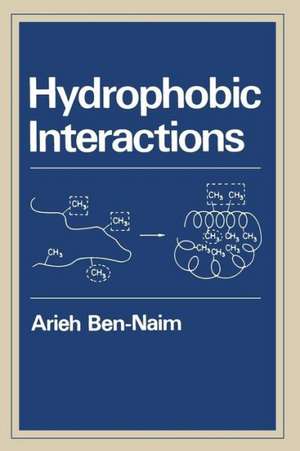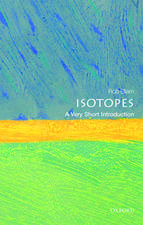Hydrophobic Interactions
Autor Arieh Y. Ben-Naimen Limba Engleză Paperback – 13 mar 2012
Preț: 389.11 lei
Nou
Puncte Express: 584
Preț estimativ în valută:
74.46€ • 77.59$ • 61.65£
74.46€ • 77.59$ • 61.65£
Carte tipărită la comandă
Livrare economică 03-17 aprilie
Preluare comenzi: 021 569.72.76
Specificații
ISBN-13: 9781468435474
ISBN-10: 1468435477
Pagini: 328
Ilustrații: 320 p.
Dimensiuni: 152 x 229 x 17 mm
Greutate: 0.44 kg
Ediția:Softcover reprint of the original 1st ed. 1980
Editura: Springer Us
Colecția Springer
Locul publicării:New York, NY, United States
ISBN-10: 1468435477
Pagini: 328
Ilustrații: 320 p.
Dimensiuni: 152 x 229 x 17 mm
Greutate: 0.44 kg
Ediția:Softcover reprint of the original 1st ed. 1980
Editura: Springer Us
Colecția Springer
Locul publicării:New York, NY, United States
Public țintă
ResearchCuprins
1. Introduction and Fundamental Equations.- 1.1. What Are Hydrophobic Interactions?.- 1.2. The Fundamental Expression for the Chemical Potential.- 1.3. Definition of Hydrophobic Interaction (HI).- 1.4. Probability Interpretation.- 1.5. Integrals Involving gss(R).- 2. Very Dilute Solutions and Hydrophobic Interaction.- 2.1. Introduction.- 2.2. Standard Free Energies of Transfer.- 2.3. Some Numerical Examples of ??tr° between Pure Phases.- 2.4. Some Numerical Examples of ??tr° between More Complex Phases.- 2.5. Survey of Theoretical Methods of Estimating ??tr°(G ? W).- 2.6. Some Words of Caution.- 3. Pairwise Hydrophobic Interaction (HI).- 3.1. Introduction.- 3.2. The Full Pair Correlation Function gss(R).- 3.3. Values of ?GHI at One Specific Distance.- 3.4. Effect of Variation of the Solvent on ?GHI(?1).- 3.5. Solute-Solute Affinity at Infinite Dilution.- 3.6. Solute-Solute Affinity at Finite Concentrations.- 3.7. Dimerization Equilibrium.- 3.8. Ion-Pair Formation by Double Long-Chain Electrolytes.- 3.9. Kinetics of Aminolysis by Long-Chain Alkylamines of Some Long-Chain Esters of p-Nitrophenol.- 3.10. Application of NMR and ESR Techniques.- 4. Hydrophobic Interaction among Many Solute Particles.- 4.1. Introduction.- 4.2. A Specific Example for Demonstrating the Nonadditivity Effect.- 4.3. The Relation between HI and the Standard Free Energy of Aggregation.- 4.4. Approximate Measure of the HI among m Solute Particles.- 4.5. An Improved Approximate Measure of the HI.- 4.6. Application of the Scaled-Particle Theory (SPT).- 4.7. A Direct Measure of Intramolecular HI.- 4.8. HI in Aqueous Micellar Solutions.- 4.9. HI in Synthetic and Biological Polymers.- 5. Temperature and Pressure Dependence of the Hydrophobic Interactions.- 5.1. Introduction.- 5.2.Temperature and Pressure Derivatives of the Standard Free Energy of Transfer.- 5.3. Temperature and Pressure Derivatives of the HI.- 5.4. Experimental Observations on the Temperature Dependence of the HI.- 5.5. Experimental Information on the Pressure Dependence of the HI.- 5.6. Formal Statistical Mechanical Expressions for the Entropy, Enthalpy, and Volume Changes Associated with the HI.- 5.7. Definition of the Structure of Water (SOW).- 5.8. How Much Structural Change in the Solvent?.- 5.9. Effect of Structural Changes in the Solvent (SCIS) on the Thermodynamics of Solubility and HI.- 5.10. A Simple Solvable Model.- Appendixes.- A.1. The Fundamental Equation for the Chemical Potential in a Two-Component System.- A.2. Conditional Standard Free Energy of Transfer.- A.3. Dimerization Free Energy of Molecules of the Type R-Y.- A.4. Rudiments of the Scaled-Particle Theory (SPT).- A.5. Conformational Change of a Biopolymer and Standard Free Energy of Transfer.- A.7. Standard Free Energy of Solution of Solute Molecules Having Internal Rotations.- A.8. On the Solvent Contribution to the Standard Free Energy of Micelle Formation.- A.9. Standard Free Energy of Transferring a Solute from the Solvent into a Micelle.- References.











